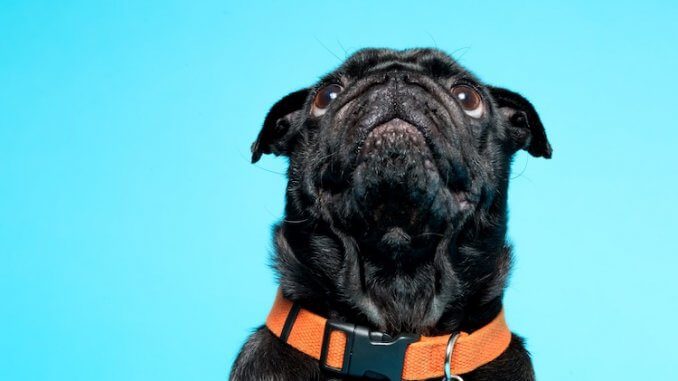
I remember a particular Black Pug named Benny, who I met while volunteering. Benny had a way of lightening the atmosphere with his playful antics and an almost human-like expression of curiosity. It’s this unique blend of characteristics that makes Black Pugs not just pets, but beloved family members. In my years of working with dogs, both as a volunteer for various animal-based charities and in my professional capacity at a Veterinary Pathology Lab, I’ve had the pleasure of encountering numerous breeds. Yet, the Black Pug, with its glossy coat, expressive face, and endearing personality, holds a special place in my heart.
However, as with any breed, there are specific considerations to keep in mind. The Black Pug price can vary widely, and understanding what contributes to these costs is crucial for potential owners. Furthermore, when considering Black Pug puppies, it’s important to be aware of their health, temperament, and the kind of care they will require.
Whether you’re drawn to the Black Pug for its striking appearance, its companionship qualities, or the sheer joy that comes from having such a characterful pet, it’s essential to arm yourself with all the knowledge necessary to ensure a happy and healthy life together. From my personal and professional experiences, I’ll guide you through everything you should know before buying a Black Pug, ensuring that you’re fully prepared for the rewarding journey that lies ahead with these delightful dogs.
TABLE OF CONTENTS
Black Pug Quick Breed Summary
Black Pug Breed Overview
The Black Pug is a variant of the Pug breed.
Pugs have long been cherished as companion dogs, their unique and endearing appearance combined with their loving nature ensuring their popularity through the ages. Belonging to the toy group, they are celebrated for their compact, manageable size, making them ideal for a variety of living situations.
At their core, Pugs are profoundly family-oriented, possessing a deep-seated desire to please and entertain their human companions. However, there’s a depth to this breed that goes beyond their initial appeal. They exhibit a playful mischievousness, often paired with a distinctive stubborn streak, adding layers to their personality that are both amusing and challenging.
Their spirited demeanor and somewhat headstrong attitude reveal a character full of surprises, demanding patience and understanding from their owners. This combination of traits makes the Pug, especially the Black Pug, not just a pet, but a lively member of the family, full of love, laughter, and a dash of unpredictability.
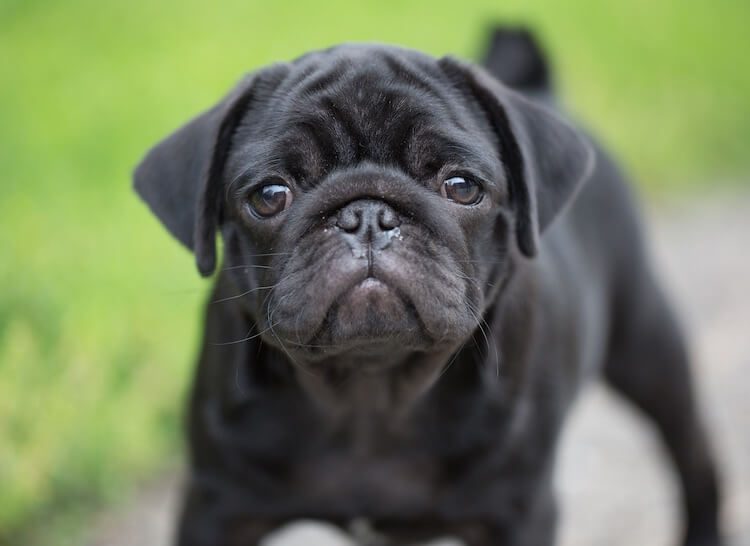
Breed History
The Pugs boasts a history as rich and fascinating as its fawn counterparts. Originating from China around 400 BC, Pugs were treasured by Chinese emperors and lived in luxurious accommodations, often guarded by soldiers. These dogs, with their distinctive black coats, made their way to Europe in the 16th century, quickly becoming favored pets among European royalty and nobility. The Pug’s history is intertwined with tales of loyalty and charm, serving as a testament to their enduring appeal.
Today, the Pug is celebrated not just for its historical significance but for its role as a beloved companion. Renowned for their sociable and gentle disposition, Pugs have cemented their status in the hearts of dog lovers worldwide. Their compact size and adaptable nature make them perfect for both apartment living and homes with spacious yards. Despite their royal lineage, Pugs are anything but aloof; they thrive on human interaction and are known for their playful and affectionate demeanor.
Black Pug Origin
While the exact origins of the Black Pug’s color variation are not documented with the same precision as the breed’s initial introduction to the West, it is widely recognized that this color variant became prominent in the 19th century. The Black Pug is not the result of a crossbreed but rather a natural variation within the Pug breed itself. A genetic mutation allowed for the manifestation of the solid black coat, distinguishing it from the more traditional fawn coloration with its distinct black mask.
This color variant was initially less common, adding a layer of uniqueness and desirability to the Black Pug. Over time, dedicated breeding programs emphasized this distinctive coat color, leading to the Black Pug’s increased popularity and presence within the breed. Today, the Black Pug is fully recognized and cherished for its sleek, glossy coat and the same endearing qualities that have made Pugs beloved companions throughout history.
As a volunteer and someone who works closely with animals, I’ve seen firsthand how Black Pugs can bring joy and companionship to families and individuals alike. Their rich history and charismatic presence make them not just pets, but a link to a storied past, continuing to capture the hearts of those they encounter.
Kennel Club Recognition and Pedigree
The Pug, one of the most venerable purebreds known to history, has been acknowledged by major kennel clubs worldwide, classifying it within the esteemed toy group for its petite stature and companionable nature.
The American Kennel Club (AKC) extended its recognition to the Pug as early as 1885, marking a significant milestone in the breed’s history in the West. This acknowledgment was further solidified with the establishment of the Pug Dog Club of America in 1931, which played a pivotal role in promoting the breed’s interests and standards. In a testament to the Pug’s global appeal and the efforts of breed enthusiasts, the World Canine Organization (also known as the Fédération Cynologique Internationale) officially recognized the Pug in 1966, further elevating its status on the international stage.
In the contemporary era, the Black Pug, with its distinctive glossy coat and captivating charm, enjoys recognition from numerous prestigious kennel clubs and organizations around the world. This includes:
- The Australian National Kennel Council (ANKC),
- The Canadian Kennel Club (CKC),
- The Kennel Club (KC) in the United Kingdom,
- The New Zealand Kennel Club (NZKC),
- And the United Kennel Club (UKC).
Each of these organizations acknowledges the Black Pug’s unique qualities and contributions to the toy breed group, reinforcing its beloved status among dog enthusiasts and families alike. This widespread recognition is a testament to the Black Pug’s enduring appeal and the dedicated efforts of breeders and clubs to maintain the breed’s high standards and health.
Black Pug Puppies
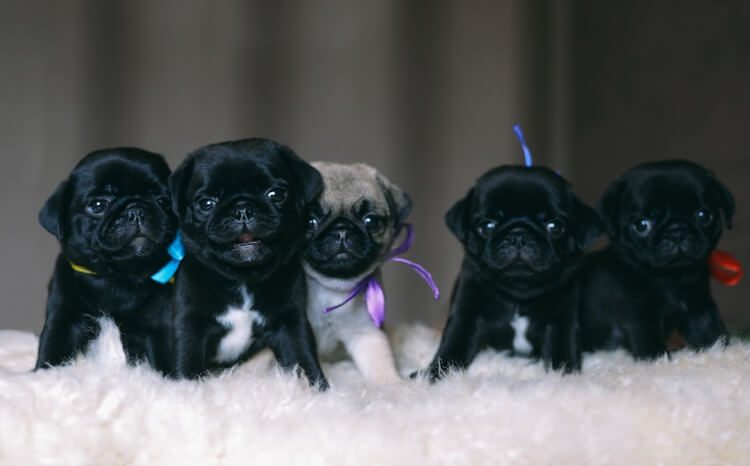
Bringing a Black Pug puppy into your home is akin to adding a bundle of joy with a personality larger than life itself. These little charmers, with their soulful eyes and gleeful disposition, are more than just pets; they become an integral part of the family from the moment they prance through your door. However, welcoming one of these affectionate companions into your life comes with considerations, particularly regarding their price and the commitment to their well-being.
By the time they reach 8 weeks of age, these puppies begin to exhibit their adventurous spirit, venturing away from their mother and showing readiness to embrace life in their new forever homes. At this tender age, they typically weigh between 2 to 4 pounds, small enough to cradle in your arms yet big enough to start engaging with the world around them.
The litter size for Pugs can vary quite a bit, reflecting the breed’s diverse nature. While the average litter consists of 4 to 6 puppies, it’s not uncommon for a Pug to have as few as 1 or as many as 9 puppies. This variability adds another layer of anticipation and excitement to the process of welcoming a Black Pug puppy into your life.
In today’s economy, the price range for Black Pug puppies can vary significantly based on several factors, including breeder reputation, geographical location, and lineage. Typically, you can expect to invest anywhere from $1,000 to $2,500 for a Black Pug puppy. This price range reflects not just the demand for this specific color variant but also the care and attention breeders must invest in ensuring the health and well-being of the puppies and their parents.
It’s essential to approach the acquisition of a Black Pug puppy with a mindset geared towards responsible ownership. The initial cost is just the beginning, as these delightful companions require proper healthcare, nutrition, and socialization. Prospective Black Pug owners should also consider the breed’s specific needs, including potential health issues common to Pugs, such as respiratory and eye conditions, and be prepared for the associated veterinary costs.
Choosing a reputable breeder is crucial; they should offer transparency about the puppy’s health history and the conditions in which the puppies are raised. A responsible breeder will also show a keen interest in the puppy’s future home, ensuring it’s a good match for their temperament and needs.
Adopting a Black Pug puppy is a long-term commitment filled with moments of joy, companionship, and unconditional love. It’s a decision that should be made with careful consideration of both the financial investment and the commitment to provide a loving, forever hom
Black Pug Personality
The personality of Black Pugs is a delightful tapestry of charm, mischief, and affection, making them one of the most endearing breeds for families and individuals alike. These compact companions are known for their sociable nature, thriving on human interaction and forming deep bonds with their owners. Their expressive, almost human-like faces mirror a range of emotions, from joy and curiosity to empathy and contentment, engaging their human counterparts on a profound level.
Sense of Companionship
Black Pugs possess an innate sense of companionship, often shadowing their owners from room to room, eagerly participating in household activities. They exhibit a playful demeanor, always ready for a game or a gentle wrestle, yet they are equally content curled up on a lap, snoring softly. This balance between playfulness and placidity makes them versatile companions, adaptable to various lifestyles and environments.
Sense of Humor
Moreover, Black Pugs are renowned for their great sense of humor. They have a penchant for performing and can often be found at the center of attention, engaging in antics that bring laughter and lightness to their homes. This mischievous streak, coupled with their undeniable cuteness, often makes it difficult for owners to stay firm when discipline is needed.
Stubborn Streak
Despite their playful and jovial nature, Black Pugs can exhibit a stubborn streak. Training them requires patience, consistency, and a positive reinforcement approach. They respond well to food rewards and praise, and while they may not be the top performers in obedience classes, their eagerness to please and capacity for learning basic commands can make the training process enjoyable for both the Pug and their owner.
In essence, the personality of a Black Pug is a blend of affection, loyalty, and a touch of comedy, making them not just pets, but beloved members of the family. Their ability to connect emotionally with their humans, combined with their spirited character, ensures a rich and rewarding companionship filled with love, laughter, and the occasional bit of mischief.
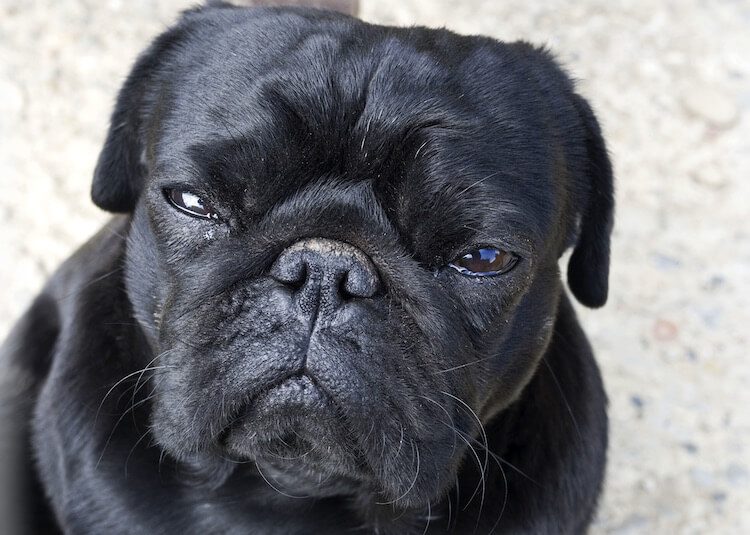
Family Compatibility
Black Pugs are exceptionally compatible with families, including those with children. Their affectionate nature, combined with a sturdy and forgiving temperament, makes them ideal companions for households of all sizes. Their playful and gentle demeanor endears them to both adults and children alike, fostering an environment of mutual respect and love.
For families with kids, Black Pugs offer several advantages. Their small size ensures they are manageable for younger family members, yet they possess enough resilience to engage in play without being overly fragile. Pugs are known for their patience and are rarely aggressive, making them a safe choice for families concerned about the temperament of their canine companion.
However, it’s essential to teach children how to interact with dogs properly, respecting their space and understanding their body language. Black Pugs, with their expressive faces and communicative behavior, can help children learn about responsible pet ownership and empathy for animals. Additionally, their social nature means they often enjoy being part of family activities, whether it’s a quiet evening at home or a lively family gathering.
One consideration for families is the Black Pug’s need for moderate exercise and their susceptibility to heat due to their brachycephalic (short-nosed) facial structure. Families should be prepared for indoor play during hot weather and gentle outdoor activities when the temperature allows.
Black Pug Physical Characteristics
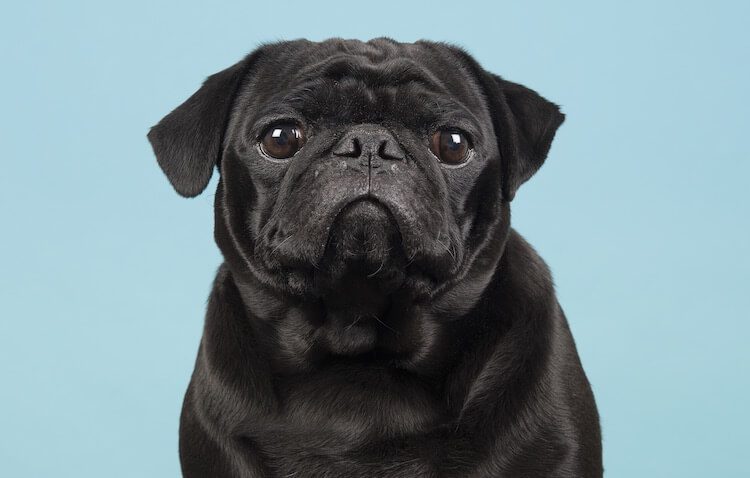
As with a typical Pug, when Black Pugs reach full maturity, they embody a compact and square stature, characteristic of their breed. Typically, a fully grown Black Pug stands about 10 to 13 inches tall at the shoulder and weighs between 14 to 18 pounds. Despite their small size, they have a solid and muscular build, with a significant presence that belies their dimensions.
Appearance
The appearance of a Black Pug is marked by its distinctive, deeply wrinkled forehead and large, expressive eyes that shine with intelligence and affection. Their short, snub nose and wide-set eyes give them a unique, endearing facial expression. Their ears can be either “rose” or “button” style, adding to their charm. The tail is another notable feature, tightly curled over the hip in a spiral that is as functional as it is decorative, serving as a hallmark of the breed’s silhouette.
Color Types
While this section focuses on the Black Pug, it’s worth noting that Pugs generally come in two primary color variations: fawn and black. The Black Pug is entirely covered in a sleek, glossy black coat that shines in the light, offering a striking contrast to the fawn variety, which is characterized by a light tan or yellow coat with a distinctive black mask.
Coat
The coat of a Black Pug is short, smooth, and soft to the touch, lying flat against the body. This type of coat requires regular grooming to manage shedding and maintain its lustrous appearance. Despite the simplicity of their coat, Black Pugs can still shed quite a bit, so regular brushing is recommended to keep loose hair under control. Their skin needs attention as well; the deep wrinkles on their face should be cleaned regularly to prevent dirt accumulation and ensure the skin remains healthy.
Pug Dog Care Guide

These furry friends are the ideal pet for any novice owner as they have a very friendly and loving character. Their small size and minimal exercise requirements make them great for those in apartments or houses.
Food and Dietary Requirements
For toy breeds like the adult Black Pug, dietary needs are quite specific: they require about 40 calories per pound of body weight each day, a figure that may decrease as they age and their energy needs diminish.
In their formative months, up to the age of 6 months, it’s essential to feed these puppies three times daily to support their rapid growth and development. As they transition into juvenility at six months, reducing their meals to twice a day aligns better with their changing dietary requirements. Upon reaching adulthood, Black Pugs typically adapt well to being fed once a day, although some owners prefer to divide this into two smaller servings—one in the morning and another in the evening—to maintain a steady energy level throughout the day.
The dietary regimen for Black Pugs should consist of high-quality dry food tailored for small breed dogs, lightly moistened with water to facilitate ease of eating. This breed’s nutritional plan, especially in adulthood, is crucial in managing their weight and overall health. Given their propensity towards obesity and the associated breathing difficulties—a concern accentuated by their brachycephalic nature—it’s advisable to resist the temptation to offer table scraps or excessive treats. Maintaining a disciplined feeding schedule and portion control plays a pivotal role in preventing weight gain and ensuring the longevity and well-being of your Black Pug.
Exercise Requirements
These delightful canines may have petite legs, but they still require regular exercise to maintain their health and happiness. Two daily walks, each lasting about twenty minutes, provide the perfect amount of physical activity for them without overexertion. To keep their walks engaging, consider varying your routes occasionally. This introduces them to new environments, stimulating their senses with fresh sounds and scents.
Pugs thrive on social interaction, making them excellent companions for visits to the dog park, beach, or exploring local walking paths. Their friendly nature ensures they usually enjoy these outings without any issues.
However, Black Pugs have a unique consideration: their dark coats absorb more heat, making them prone to overheating in direct sunlight. To safeguard their well-being, schedule walks during the cooler parts of the day, such as early morning or late evening. Additionally, during warmer days, it’s crucial to provide ample water to keep them hydrated and comfortable.
Considering their brachycephalic (short-nosed) facial structure, opting for a full-body harness can significantly enhance their comfort during walks. Unlike traditional collars, a full-body harness distributes pressure more evenly across their body, reducing stress on their throat and airways and facilitating easier breathing. This small adjustment can make a big difference in ensuring your Black Pug’s outings are both enjoyable and safe.
Grooming
The sleek, smooth coat of the Black Pug is relatively low-maintenance, yet it does necessitate regular care to manage shedding. A weekly brushing session is vital to remove loose fur and maintain their coat’s health, helping to control the natural shedding process and keep their black coat shiny.
Bathing your Black Pug doesn’t have to be a frequent task but aiming for a monthly schedule is ideal. Given their prominent eyes, it’s important to select a shampoo specifically designed to be gentle on Pugs, avoiding harsh chemicals that could cause irritation. Pug-friendly shampoos will ensure the bathing experience is safe and enjoyable for your pet.
Special attention should be paid to the unique facial wrinkles of your Black Pug during their bath time. These folds can harbor dirt and bacteria, leading to potential infections if not cleaned regularly. Gently cleanse these areas with cotton balls or specially formulated pet wipes, ensuring they are thoroughly dried afterwards to prevent moisture accumulation.
Additionally, oral hygiene cannot be overlooked for small breeds prone to dental issues, such as Pugs. Daily tooth brushing with a dog-specific toothpaste can significantly reduce the risk of gum disease and other dental problems. Establishing a routine for dental care from an early age is crucial in ensuring your Black Pug’s long-term health and well-being.
Training
Pugs are indeed a breed that combines intelligence with a dash of stubbornness. Despite their occasional obstinacy, once they grasp what you expect from them, training should progress smoothly. Here are some tailored puppy training tips for your Black Pug that honor their unique personality and needs.
Their sensitive nature means that harsh discipline is not only ineffective but could harm their trust in you and dampen their spirited disposition. Instead, adopt a strategy of abundant praise and positive reinforcement. This approach nurtures their willingness to learn and maintains their joyful spirit, fostering a well-adjusted and confident dog.
As naturally sociable creatures, Black Pugs revel in interaction and playtime with their human family. They thrive on affection and engaging activities but also require adequate mental stimulation. After a lively play session, presenting them with a puzzle feeder can be an excellent way to keep their minds active. Such toys challenge their problem-solving skills, offering mental enrichment that keeps them content and intellectually stimulated.
Embracing these training and engagement methods acknowledges the unique blend of characteristics that make Black Pugs such beloved companions. It ensures their physical and emotional needs are met, allowing them to flourish within the family environment.
Black Pug Known Health Problems
Black Pugs, like their fawn counterparts, are brimming with personality and charm, but they also share a predisposition to certain health issues that prospective and current pet parents should be aware of. While there are no health problems exclusive to the Black Pug due to their coat color, the breed as a whole is prone to specific conditions that require attention and care.
Brachycephalic Syndrome
Due to their distinctive short-nosed (brachycephalic) facial structure, Black Pugs can experience breathing difficulties. This condition can lead to snoring and may cause challenges with exercise, especially in hot weather or during intense physical activity. Ensuring your Black Pug stays cool and avoiding overexertion are key to managing this condition.
Skin Infections
The deep wrinkles and folds on a Black Pug’s face are characteristic and endearing but can also harbor bacteria and yeast if not cleaned regularly. This can lead to skin infections. Regular, gentle cleaning of these folds with appropriate wipes or cloths is essential for maintaining skin health.
Obesity
Pugs are known for their hearty appetites, putting them at risk for obesity. This can exacerbate breathing difficulties and lead to other health issues, such as joint problems and diabetes. A balanced diet and regular exercise are crucial for keeping your Black Pug at a healthy weight.
Eye Problems
Their prominent eyes make Black Pugs susceptible to various eye conditions, including corneal ulcers and dry eye. Prompt attention to any signs of eye discomfort or visual impairment is critical to prevent serious complications.
Joint Issues
Pugs can suffer from joint problems, such as hip dysplasia and patellar luxation. Keeping your Pug at a healthy weight can help mitigate the risk of these conditions.
FAQs About Black Pugs
How long do Black Pugs typically live?
Black Pugs have a lifespan that generally ranges between 12 to 15 years. This longevity is contingent upon a variety of factors including genetics, overall health management, diet, and level of physical activity. Ensuring regular veterinary care, maintaining a healthy weight, and providing mental stimulation can contribute significantly to extending their life. Like all dogs, Black Pugs thrive on love, attention, and proper care, which plays a crucial role in their overall well-being and longevity. Early detection and management of common health issues associated with the breed can also help in maximizing their life expectancy.
Can Black Pugs handle hot weather?
Due to their brachycephalic facial structure, Black Pugs can struggle in hot weather, more so than many other breeds. Their short nasal passages make it difficult to regulate their body temperature through panting, which can lead to overheating. It’s crucial to keep Black Pugs in a cool, shaded environment during hot days and provide them with plenty of water. Exercise should be limited to cooler parts of the day, such as early morning or evening. Additionally, their black coat absorbs more heat, so extra caution should be taken to prevent overheating.
Are Black Pugs good with other pets?
Black Pugs are generally known for their sociable and amiable nature, making them good companions for other pets in the household. They typically get along well with other dogs and can also coexist peacefully with cats, especially if introduced properly and at a young age. However, individual temperaments can vary, so it’s important to supervise initial interactions and provide gradual introductions. Socialization from a young age can help ensure that a Black Pug grows up to be well-adjusted and friendly towards other animals. Their playful and loving disposition often makes them a beloved member of a multi-pet household.
Do Black Pugs shed a lot?
Despite their short coat, Black Pugs are known to shed quite a bit. Their shedding is consistent throughout the year, and it can increase seasonally. Regular brushing, at least once a week, can help manage shedding by removing loose hairs and distributing skin oils throughout their coat, which in turn can help to minimize the amount of hair shed around the house. Investing in a good vacuum and keeping lint rollers handy are also useful tips for Pug owners. Proper nutrition and regular grooming can help keep shedding under control, but prospective owners should be prepared for a moderate amount of hair.
What kind of training do Black Pugs need?
Black Pugs benefit from early socialization and basic obedience training, like any other dog breed. They are intelligent but can be stubborn, so patience and consistency are key in their training. Positive reinforcement techniques, such as treats and praise, work best with this breed, encouraging them to learn and engage in the training process. Training sessions should be kept short and fun to maintain their interest and prevent boredom. Additionally, since Black Pugs are eager to please their owners and enjoy attention, they often respond well to training that involves interactive and engaging activities.
Assessing Whether a Black Pug is Your Ideal Companion
Black Pugs, with their glossy coats and affectionate nature, make for charismatic and endearing pets. Deciding if this particular breed fits into your life and home is an important step. Here’s a concise guide to help you figure out if a Black Pug might be the perfect addition to your family.
Yes, a Black Pug is right for you if…
- You Prefer a Loyal and Affectionate Companion: Black Pugs are known for their loving nature and strong bond with their owners. If you’re seeking a devoted friend who loves snuggles and companionship, this breed could be your match.
- You Live in an Apartment or Have Limited Space: Thanks to their compact size, Black Pugs are well-suited to apartment living. They don’t require a backyard and are happy as long as they’re close to their humans.
- You Want a Dog With a Moderate Energy Level: While playful and spirited, Black Pugs aren’t as high-energy as some breeds. They enjoy their playtime but are equally content with relaxing by your side, making them suitable for a variety of lifestyles.
- You Can Commit to Regular Grooming: Their short, sleek coat does shed, but regular brushing can manage this. Plus, their facial wrinkles need cleaning to prevent skin issues, a grooming task that can easily become a bonding routine.
No, a Black Pug may not be right for you if…
- You’re Looking for an Outdoor Adventure Companion: If you’re an outdoor enthusiast looking for a dog to join on long hikes or runs, the Black Pug might not be the best fit due to their brachycephalic nature and susceptibility to overheating.
- You Need a Dog That’s Low Maintenance: Despite their small size, Black Pugs require a fair amount of care. From their potential health issues to their grooming needs and sensitivity to temperature extremes, they need attentive owners.
- You Prefer a Quiet Household: Black Pugs can be quite vocal, expressing themselves with a range of sounds. If you’re seeking a quieter breed, a Black Pug’s enthusiastic barks and snores might not align with your preferences.
- You Spend Long Hours Away From Home: Black Pugs thrive on companionship and can develop separation anxiety if left alone for extended periods. They’re happiest in homes where they can interact frequently with their family members.
Final Insights: Should You Get a Black Pug?
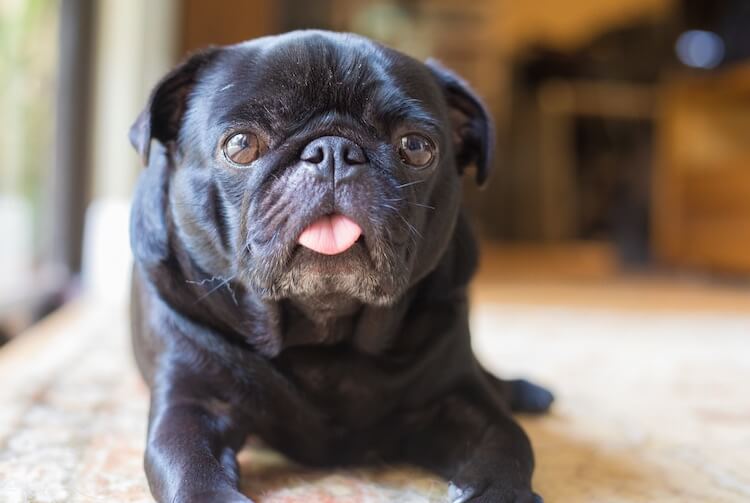
The Black Pug stands out as an exceptional choice for those embarking on the journey of pet ownership. With their cheerful disposition and compact size, these charming canines offer a perfect opportunity to master the responsibilities of being a dedicated dog parent.
Ideal for novices of any age, Black Pugs adapt seamlessly to the confined spaces of city living and the more expansive environments of family homes alike. For those yearning to lavish affection and care on a pet, the Black Pug eagerly awaits your attention and devotion.
However, it’s important to consider their specific needs, especially regarding their climate sensitivity. Their brachycephalic nature means they thrive in cooler temperatures, ensuring easier breathing and overall comfort. As they age, it’s true that respiratory challenges may become more pronounced, accompanied by a tendency to snore—a minor inconvenience when weighed against the joy and loyalty they bring.
Embracing a Black Pug into your life means welcoming a profoundly kind-hearted, affectionate, and faithful companion. Their presence is a constant source of happiness and love, making any additional care they may require well worth the effort. If you’ve had the pleasure of sharing your life with a Black Pug, we’d love to hear about your experiences in the comments below.


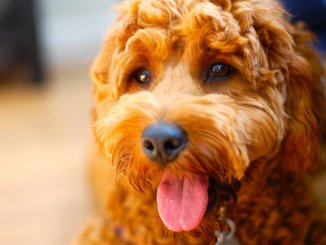
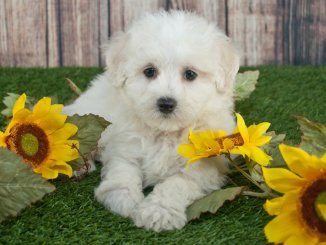
We have an 8week old black pug puppy. This is our second black love pug. They love people and other dogs and cats.
What would you recommend as a good pug shampoo? I rescued a pug mix July 20th. I have him on a good lamb dog food and his coat has improved greatly.
Thanks for your question. Do you have specific skin issues that you are hoping to tackle with a shampoo? If you are concerned about your Pug’s skin, pop to chat with your Veterinarian. If you are looking for a standard shampoo, we love the Earthbath products. Adding supplements like essential fatty acids to food can also support a dog’s coat. But always speak with your Veterinarian before adding anything new to your dog’s diet.
I recently adopted a 13yo black pug mix as well. I adore her! I, too, am researching food, shampoo, and care. So, I can’t answer your question, but I just wanted to share in your excitement. Merry Christmas.
We use Adams flea and tick shampoo and it fantastic!
My second Pug is 6 years old and cost 1600.00. He breathes without problems. Chief is my second black pug. Winston my first lived 14 years. ROYAL CIANIN FOOD only and healthy treats. 20 lb
Have had my first black pug since October. He is five and rehomed as the previous family had a change of circumstances.
From your report he is a typical pug. Very very loving. Very very greedy. He has no breathing problems. Weighs 8 kilos and is quite small and dainty. He settled to our routine and way of doing things very soon after he came. He is a great joy to us with his funny quirky ways. Love him to bits.
LOVE my black pug Auggie! Best dog in the entire world!!!. I am absolutely in love with him! No problems breathing, healthy happy dog. We usually go to the Pug meets. If you want some great therapy go and immerse yourself in a room full of pugs… it is heaven!
Our first dog was a black pug called Molly who we lost earlier this year at age 9 years almost 10 years. She was the love of our lives and is greatly missed. They are a true joy to have as pets but do come with health issues that need lots of care and attention.
I really love my three month old pup. She is a pure joy! BUT! She is very hyper and plays, chews, bites pretty much all day, between short naps. I can’t have her in my lap without getting chewed! Yes, I’ve tried all the suggested tips. The whole living room is full of toys. Question is, will she ever outgrow this?
Hi Linda, yes this is completely normal for a puppy!
I think this is one of the most significant pieces of information for me. And I’m glad read your article. Thank you for sharing! Pugs are the best company, the most entertaining, heartbreakingly adorable, NAUGHTY, sweet angels.
I love my Presley so much. He’s the best pup. These last two years have been personally horrendous, and he steps on my chest and smells my eyes (happy tears are chemically different than sad tears) and if I’m sad he just puts his face on mine and lays on my chest like a hug. I don’t know what I’d do without him.